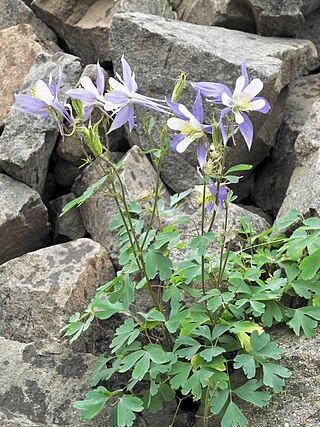
Aquilegia coerulea, the Colorado columbine, Rocky Mountain columbine, or blue columbine, is a species of flowering plant in the buttercup family Ranunculaceae, native to the Rocky Mountains and some of the surrounding states of the western United States. It is the state flower of Colorado. The Latin specific name coerulea means "sky blue".

Berberis repens commonly known as creeping mahonia, creeping grape holly, or creeping barberry, is a species of Berberis native to most of the western United States and two western provinces of Canada. It is low growing shrub that spreads by underground stems. As a species it is well adapted to fire and is a very common understory plant in western forests. An evergreen species, it provides food to deer and elk in winter and can make up a significant part of their diet. The berries are eaten by birds and small mammals, aiding it in spreading to recently disturbed areas. It has found use as a xeric ornamental plant and has escaped from cultivation in areas beyond its native range.
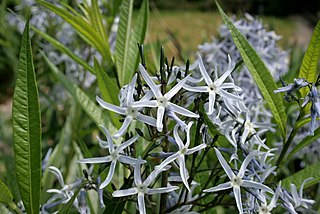
Amsonia is a genus of flowering plants in the dogbane family, Apocynaceae, first described as a genus in 1788. It is native primarily to North America with one species in East Asia and another in the eastern Mediterranean. It was named in honor of the American physician John Amson. Members of the genus are commonly known as bluestars.
- Amsonia ciliataWalter – fringed bluestar – SE US, S Great Plains
- Amsonia elliptica(Thunb. ex Murray) Roem. & Schult. – Japanese bluestar – China, Japan, Korea
- Amsonia fugateiS.P.McLaughlin – San Antonio bluestar – New Mexico
- Amsonia grandifloraAlexander – Arizona bluestar – Arizona, Sonora, Durango
- Amsonia hubrichtiiWoodson – Hubricht's bluestar – Arkansas, Oklahoma
- Amsonia illustrisWoodson – Ozark bluestar – Mississippi Valley, also Nevada
- Amsonia jonesiiWoodson – Jones' bluestar – Arizona, New Mexico, Utah, Colorado
- Amsonia kearneyanaWoodson – Kearney's bluestar – Baboquivari in Pima Co. in Arizona
- Amsonia longifloraTorr. – tubular bluestar – Arizona, New Mexico, Texas, Coahuila
- Amsonia ludovicianaVail – Louisiana bluestar – Louisiana, Mississippi, Georgia
- Amsonia orientalisDecne. – European bluestar – Greece, Turkey
- Amsonia palmeriA.Gray – Palmer's bluestar – Arizona, New Mexico, Texas, Sonora, Chihuahua
- Amsonia peeblesiiWoodson – Peebles' bluestar – Arizona
- Amsonia repensShinners – creeping bluestar – E Texas, SW Louisiana
- Amsonia rigidaShuttlw. ex Small – stiff bluestar – from Georgia to Louisiana
- Amsonia tabernaemontanaWalter – eastern bluestar – S + C + E United States
- Amsonia tharpiiWoodson – feltleaf bluestar – W Texas, SE New Mexico
- Amsonia tomentosaTorr. & Frém. – woolly bluestar – SW US; Chihuahua

Amsonia hubrichtii, commonly known as Hubricht's bluestar, Arkansas bluestar, or thread-leaf bluestar, is a North American species of perennial flowering plant in the Apocynaceae (dogbane) family, first described in 1943. It is native to Oklahoma and Arkansas in the south-central United States. It is commonly used as an ornamental plant.

Symphyotrichum laeve is a flowering plant native to Canada, the United States, and Coahuila (Mexico). It has the common names of smooth blue aster, smooth aster, smooth-leaved aster, glaucous Michaelmas-daisy and glaucous aster.
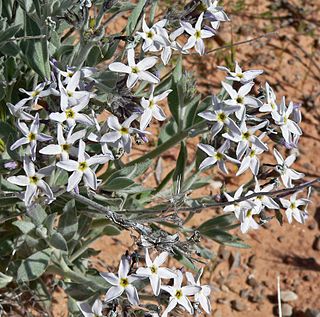
Amsonia tomentosa is a species of flowering plant native to the southwestern United States and northern Mexico (Chihuahua). Its common names include woolly bluestar and gray amsonia.
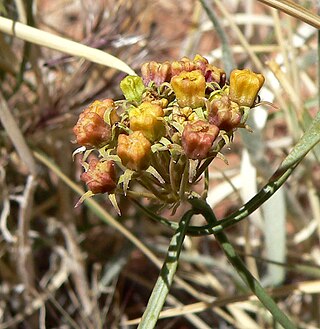
Funastrum utahense, synonym Cynanchum utahense, is a species of flowering plant in the genus Funastrum of the family Apocynaceae, known by the common names Utah swallow-wort and Utah vine milkweed. This relatively uncommon perennial vine is native to the Mojave Desert from California, Nevada, Utah and Arizona in the United States. This is a small vine with a highly branched, twining stem rarely exceeding a meter in length with which it physically supports itself on other shrubs and trees. It has small narrow leaves a few centimeters long. Its flowers are bright yellow to orange and grow in umbels. The fruit is a grooved follicle several centimeters long.

Argyrochosma jonesii, known as Jones' false cloak fern, is a species of fern native to the southwestern United States and Sonora, Mexico. It grows on calcareous rocks, and has small, finely-divided leaves with a leathery texture and dark axes connecting the leaf segments. Unlike many members of Argyrochosma, it does not secrete white powder on the underside of its leaves. First described as a species in 1917, it was transferred to the new genus Argyrochosma in 1987, recognizing their distinctness from the "cloak ferns".
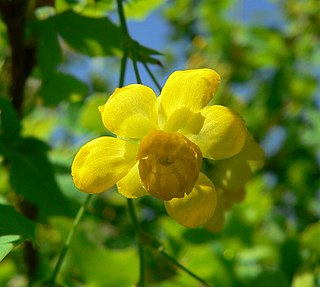
Berberis fremontii is a species of barberry known by the common name Frémont's mahonia.

Deutzia gracilis, the slender deutzia or Japanese snow flower, is a species of flowering plant in the hydrangea family Hydrangeaceae, native to Japan.

Penstemon grandiflorus, known by the common names shell-leaved penstemon, shell-leaf beardtongue, or large-flowered penstemon, is a tall and showy plant in the Penstemon genus from the plains of North America. Due to its large flowers it has found a place in gardens, particularly ones aimed at low water usage like xeriscape gardens.

Amsonia kearneyana is a rare species of flowering plant in the dogbane family known by the common name Kearney's bluestar. It is native to Arizona, where there is only one native population in the Baboquivari Mountains of Pima County. There may also be a population just south of the border in Sonora, Mexico. The plant was federally listed as an endangered species in 1989. At that time the global population of the plant was made up of eight individuals in a riparian canyon. Since that time the plant has been manually propagated in an attempt to increase its numbers. Threats to the tiny native population include habitat destruction from livestock activity and flash floods in the river canyon. Many of the plants cannot reproduce because their seeds are sterile and nonviable, but this is probably due to insect predation on the seeds as they develop.
Amsonia tharpii is a species of flowering plant in the family Apocynaceae, known by the common names Tharp's bluestar and feltleaf bluestar. It is native to New Mexico and Texas in the United States.

Tetraneuris acaulis is a North American species of flowering plants in the sunflower family. It is known by many common names in English including stemless four-nerve daisy, stemless hymenoxys, butte marigold, and stemless rubberweed.

Argemone polyanthemos, the crested pricklypoppy, also known as bluestem prickly poppy, pricklypoppy, white prickly poppy, annual pricklypoppy, or as thistle poppy is an annual plant with yellow sap and showy white flowers in the poppy family (Papaveraceae).

Mertensia lanceolata, known as prairie bluebells, lance-leaved bluebells, lance-leaved lungwort, and narrow-leaved languid ladies is a species of flowering plant native to the Rocky Mountains and areas of the northern Great Plains in western North America. A herbaceous perennial it has blue-green leaves alternately arranged on its smooth flowering stalk. Its flower buds are pink-purple and become blue as they open.

Penstemon virens, commonly known as blue mist penstemon, Front Range penstemon, or Green beardtongue, is a common Penstemon in the Front Range foothills in Colorado and Wyoming. The dainty flowers are an ornament to many rocky or sandy area within its range. It is confusingly similar to Penstemon humilis and Penstemon albertinus though the ranges of these plants do not overlap in the wild. The origin of calling it the "blue mist penstemon" is not precisely known, but is thought to relate to the large number of blue flowers the plant can produce reminding observers of a blue mist.
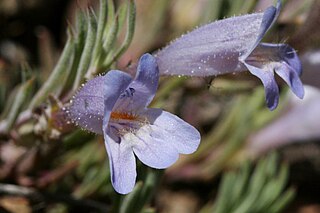
Penstemon caespitosus, commonly known as mat penstemon, is a summer blooming perennial flower in the large Penstemon genus. It is a widespread plant from near timberline to the foothills in the Southern Rocky Mountains and Colorado Plateau in North America. It is noted for its ground hugging growth habit and as a plant used in xeriscape and rock gardening.

Nolina texana, the Texas sacahuiste or Texas beargrass, is a plant in the asparagus family that resembles a large clump of grass. It grows in the south central United States and Northern Mexico. They are sometimes grown as a garden plant in xeriscape or native plant gardens.

Frankenia jamesii, known by the common names of pearly mockheather and James's sea heath, is a low growing shrub from the south-central United states from southern Colorado to the far western end of Texas. It has small leaves that are reminiscent of needle like leaves of common heather, suggesting one of its common names. It is a member of the Frankenia genus, which is the only genus in the family of flowering plants. It is best known for growing on gypsum soils.





















